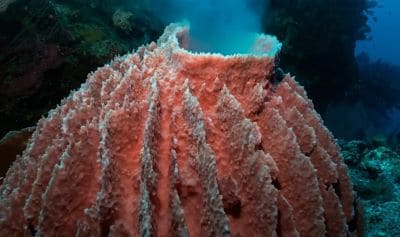Home › Sea Life › Marine › Invertebrates › Sea Sponges › Barrel Sponge
Interesting Facts about Barrel Sponges
[Phylum: Porifera (sponges)] [Class: Demospongiae] [Order: Haplosclerida] [Family: Petrosiidae]
A tube-shaped animal species has lived on coral reefs in seas and oceans for over 500 million years. Yet... they are actually fixed to the reef and cannot move around!
This guide contains fun facts and information about the giant barrel sponge (Xestospongia muta), including where the biggest species grow, what they eat, and how they reproduce.
Giant Tube Sponge Distribution and Habitat
Almost all species of sea sponges prefer to live in coral and rocky reef habitats with hard surfaces, especially:
- Bermuda
- Caribbean Sea
- Florida
- Gulf of Mexico
- The Bahamas
Several related species also grow in the Pacific and the Indian Oceans.
In many benthic regions around the world, particularly The Caribbean, giant sponges are the second most prolific of all sponge species found in coral reef ecosystems.
Fun Fact: Two giant tube sponges can occupy one square metre on many of the Florida Keys reefs. Despite this, it has a greater total biomass than all bottom-dwelling invertebrates.
Barrel Sponge Size and Characteristics
Marine biologists often invent some weird fish names, such as the red-lipped batfish. But, calling it a barrel sponge seems accurate and appropriate. After all, similar to a cask, this is a hollow cylindrical container with a bulge in the middle.
That said, giant tube sponges are animals with varying forms. Most of them are large and barrel-shaped, and they have an opening (called the osculum in sponges) at the top of the cone-shaped cavity.
Some species grow squat and low. Whereas, others are narrow and tall. The texture of the sponge surface can be smooth or rough.
Interesting Fact: Due to its size and extremely long lifespan, some scientists refer to Xestospongia muta as the "redwood of the reef".
How Big Can a Giant Barrel Sponge Grow?
It is quite common to find barrel sponges living in clusters, especially on the reefs in Florida. The internal porifera skeleton is fragile, made of silicon and calcium carbonate.
Some species grow better in shallow water around ten (10) metres (33 feet). Others have lived for thousands of years at depths over 120 metres (390 feet).
 For the most part, the stony texture contains some brown or red colouring, even though some species have a grey tint.
For the most part, the stony texture contains some brown or red colouring, even though some species have a grey tint.
But, it's not uncommon to find pink or white barrel sponges, especially those living in caves or deepwater environments.
Here's the thing...
The size of the barrel can reach a diameter of almost two (2) metres (7 feet across).
Having a fast growth rate means some specimens can grow over two metres high (up to 8 feet tall).
Because most sponges retain tremendous amounts of water, the biggest barrel sponge can weigh up to eighty (80) kilograms (180 pounds).
One of the smallest species of sponges is the calcareous sponge known as the purse sponge (Sycon ciliatum). This particular member of the animal phylum Porifera grows no bigger than five (5) centimetres long and they are most commonly found around the coastlines of Europe.
What Do Giant Barrel Sponges Eat?
The vast majority of barrel sponge species live in filter feeding environments. In other words, they are planktivores that filter, and then trap, phytoplankton and zooplankton for energy.
Because the body of a sponge is porous, it's able to remove most microscopic organisms that are suspended in the water column. Following that, the sea sponge expels unwanted waste water through the aperture at the top of its tubular barrel.
But wait - there's more:
All coral reef ecosystems tend to be healthier when there are giant bottom-dwelling sponges living nearby. This is because they help microscopic bacteria convert atmospheric carbon dioxide into organic molecules (called carbon fixation) and they play an important role in the process of nitrogen compound oxidation (i.e. nitrification).
How Does the Giant Barrel Sponge Reproduce?
In fact, the giant barrel sponge (Xestospongia muta) has only one method of reproduction. They use their osculum to eject large quantities of eggs and sperm into the water column.
Clouds of eggs and sperm start to spawn when it collides around the reef. But, the sea and ocean currents spread the fertilised larvae to other areas where they start growing into new sponges.
Threats and Predators
The exact conservation status of the giant barrel sponge is sketchy. But, it is true to say that living on fragile coral reef systems could be threatening their long term survival. As a consequence of that, the major factors include:
- Blunt trauma (e.g. from divers, fishing, shipping)
- Changing climate
- Coastal development
- Ocean acidification
- Sedimentation
- Underwater marine and garbage pollution
Plus, several fish families like to eat these large invertebrate animals for a regular source of nourishment, such as:
Pro Tip: Other serious threats to some sponge populations include the free living bacteria called "cyanobacteria symbionts" and the marine epidemic known as "sponge orange band" (SOB) disease.
Related Information and Help Guides
- A to Z List of Marine Invertebrates Examples
- Sea Sponge Facts and Information with Pictures
- Sea Fan Facts and Interesting Information
- Sea Spider Habitat and Life Cycle
- Sea Squirts: Fun Facts about Tunicates
Important: The IUCN Red List is a comprehensive information source about the global conservation status of animals, fungi, and plants.